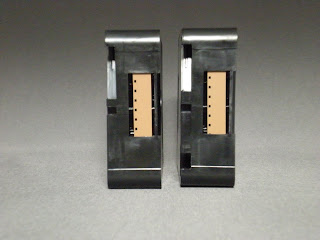

8 Tips For Shooting Modern Super 8 #2.... The 85 Filter Situation
Now here is a topic of controversy and conversation…the good old 85 filter. There are many differences of opinion about the 85 filter. This is ours at Pro8mm. – Rhonda
In the beginning, all super8 film was Tungsten Balanced, which means that the film will produce true colors under tungsten light. If you wanted to get correct colors in daylight, you had to use an orange filter called an 85 (sometimes called 85A). For convenience, every Super 8 camera was built with an internal 85 filter. The filter was usually in place because most filming was done outside in daylight. There were some clever ways to take out the filter when you were filming in Tungsten (Interior) light. The filter removal system could be activated by the super8 cartridges notch system, or by a switch, or by sticking something into a place in the camera to take it out or some combination of these things.
Every super 8 camera manufacturer had their own idea as to how this should be done. Today, you have dozens of super8 film stocks that can be either daylight or tungsten color balanced. When you film in daylight with daylight film, you do not want to use an 85 filter. At Pro8mm we have been taking the internal filters out of super8 cameras for many years now. When this is done correctly, it can greatly improve the optical performance of a camera. These inernal filters are often made of plastic which deteriorate over time and can greatly interfere with the quality of the image. They are also dirt magnets! Today because you can buy daylight film, it is actually inconvenient to have the internal 85 filter. Some film manufacturing companies prescribe to the cartridge notch for 85-filter removal and some do not. The standards for dealing with this 85 thing are a mess, so it is up to you, the filmmaker to understand what the 85 filter is and how your camera handles this. You need to make sure that you are using the correct film for your filming environment, daylight or tungsten. Although you can do some amazing color, correction in post, if you do not get this right you will never achieve the brilliance in color your images can have. In addition, all this correcting takes time, which cost money. What make this a little challenging is in most super8 cameras the 85 was placed behind the viewfinder optic where it can not be seen. If your camera has a switch or you can toggle between the two settings for filter in and out , you will not be able to see the effect of having the filter in by looking in the viewfinder.
You must open up the camera door where you insert the film and look through the camera body. Put your eye in line with what the film will see. You must run the camera in order to see through it. It also will help if you point the camera at something darker so the exposure system is open, or manually set the camera to keep the exposure wide open. Once you find a position where you can see light through the camera body, flip the switch that goes between the 85 filters in and out. You should see the light turn a darker orange when the filter is in. However, you are not done. Take the super8 cartridge you are about to use and put it in the camera. While doing so, look to see if it is flipping a lever in the camera. Now go back to check your camera and make sure that the position of the cartridge has not effected the switching. The other approach is to make sure all your settings are correct and the cartridge has the correct notch for the 85 filters. A cartridge with a notch for the 85 filters will not remove the filter automaticly. A cartridge without a notch will automatically remove the filter. In some cameras, an external switch can override this, but in others, if the notch removes the 85 filter it cannot be returned with the switch. (c) Pro8mm ™ , by Phil Vigeant, 2009
Cartridge on left is 7219 without 85 filter notch. On right, the notch added by Pro8mm
One thing you may find interesting in that we repackage the Kodak Vision 3 7219 which we call Pro8/19 ASA 500T with our prepaid processing and add the correct notch for the 85 filter. ($30 stock and processing…add a scan to Pro Ress that inclues prep and clean for one stop work flows with progressive discount, a yummy deal!) www.pro8mm.com

